Related Research Articles

The Mare Island Naval Shipyard (MINSY) was the first United States Navy base established on the Pacific Ocean. It is located 25 miles (40 km) northeast of San Francisco in Vallejo, California. The Napa River goes through the Mare Island Strait and separates the peninsula shipyard from the main portion of the city of Vallejo. MINSY made a name for itself as the premier U.S. West Coast submarine port as well as serving as the controlling force in San Francisco Bay Area shipbuilding efforts during World War II.

Arthur LeRoy Bristol, Jr. was a vice admiral in the United States Navy, who held important commands during World War I and World War II, and was an early aircraft carrier commander.

Edward Howe Watson was a career United States Navy officer, who led a squadron of destroyers aground off Point Honda on the California coast in 1923.

Samuel Lee Gravely Jr. was a United States Navy officer. He was the first African American in the U.S. Navy to serve aboard a fighting ship as an officer, the first to command a Navy ship, the first fleet commander, and the first to become a flag officer, retiring as a vice admiral.

Forrest Percival Sherman was an admiral in the United States Navy and the youngest person to serve as Chief of Naval Operations until Admiral Elmo Zumwalt in 1970. The Forrest Sherman-class destroyer and the airfield at Naval Air Station Pensacola were named for him.

The first USS Fanning (DD-37) was a modified Paulding-class destroyer in the United States Navy during World War I and later in the United States Coast Guard, designated as CG-11. Her namesake was Nathaniel Fanning.

Vice Admiral Daniel Edward Barbey was an officer in the United States Navy who served in World War I and World War II. A graduate of the Naval Academy, he participated in the 1912 United States occupation of Nicaragua and the 1915 United States occupation of Veracruz. While serving with the War Plans Section of the Bureau of Navigation in Washington, D.C. between the World Wars, developed an interest in amphibious warfare. In 1940 he produced Fleet Training Publication 167 – Landing Operations Doctrine, United States Navy, which would become the Navy's "bible" of amphibious operations, and would remain in use throughout World War II.
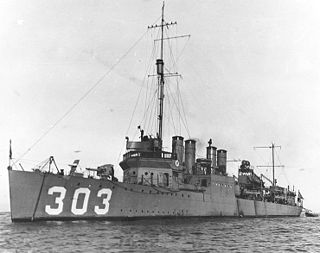
USS Reno (DD-303) was a Clemson-class destroyer built for the United States Navy during World War I.
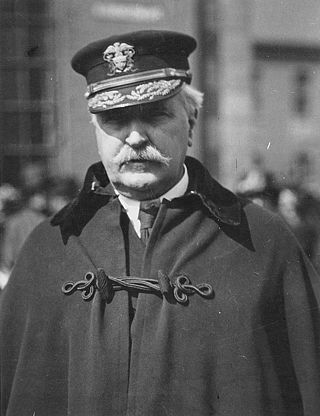
James Henry Glennon was a United States Navy officer. He saw action in the Spanish–American War, the Philippine–American War, and World War I.
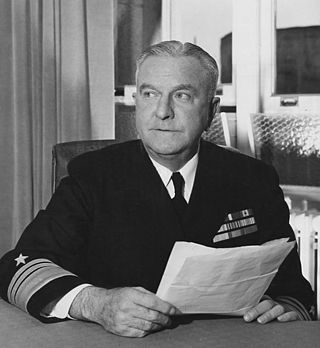
David Worth Bagley was an admiral in the United States Navy during World War II. He was also the brother of Ensign Worth Bagley, the only United States Navy officer killed in action during the Spanish–American War, and the father of Admirals David H. Bagley and Worth H. Bagley, and CIA officer Tennent H. Bagley.

Arthur Schuyler Carpender was an American admiral who commanded the Allied Naval Forces in the Southwest Pacific Area during World War II.

Rear Admiral Gilbert Jonathan Rowcliff was an officer of the United States Navy during the First World War and the Second World War. After early service in the Far East, he specialised in gunnery, serving in that capacity on many US Navy capital ships. During World War I he served with the US Naval Force sent to join the British Grand Fleet.
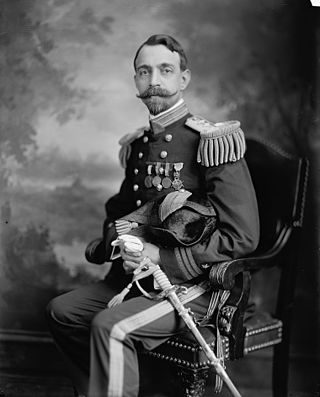
Walter Selwyn Crosley was an officer in the United States Navy. He was a recipient of the Navy Cross, the second highest military decoration for valor. He subsequently advanced to the rank of rear admiral, to date from February 17, 1927, and was transferred to the Retired List in that rank on November 1, 1935.
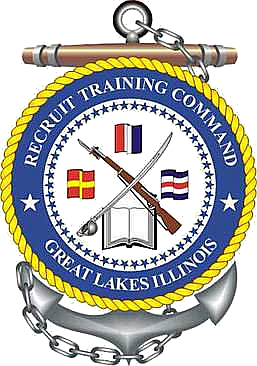
The Recruit Training Command, Great Lakes, is a command unit within the United States Navy primarily responsible for conducting the initial orientation and indoctrination of incoming recruits, also known as boot camp and recruit training, or RTC. It is part of Naval Service Training Command. It is a tenant command of Naval Station Great Lakes in the city of North Chicago, Illinois, in Lake County, north of Chicago.

Richard Lansing Conolly was a United States Navy admiral, who served during World War I and World War II.

The yeoman rate is one of the oldest rates in the U.S. Navy, dating back to 1794. Historically, the Navy yeomen were responsible for keeping the storerooms for the ship's gunners, carpenters and boatswains. With the transition from sail to steam, yeomen were assigned to the ship's engineers. In the modern Navy, a yeoman is an enlisted service member who performs administrative and clerical work.

Donald Bradford Beary was a vice admiral of the United States Navy. His career included service in both World War I and World War II and a tour as President of the Naval War College. He commanded a wide variety of ships and organizations, and is particularly noted for his leadership during World War II in establishing and directing a large-scale U.S. Navy training program and for his pioneering and highly successful work as a commander of U.S. Navy underway replenishment forces.
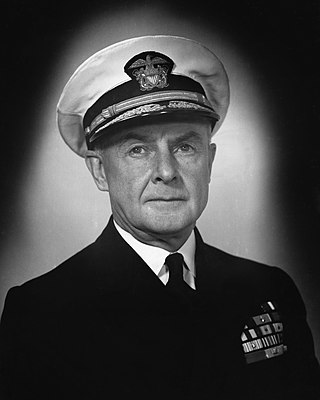
Vice Admiral Frank Jacob Lowry was an officer in the United States Navy who served in World War I and World War II. A 1911 graduate of the United States Naval Academy, he served on submarines during World War I. During World War II, he commanded the cruiser USS Minneapolis at the Battle of the Coral Sea, for which he was awarded the Navy Cross, and the Battle of Midway. He commanded the VIII Amphibious Force in the landings at Anzio and Southern France. He retired from the Navy in March 1950, and received a tombstone promotion to vice admiral due to his combat decorations.

Henry David Cooke Jr. was a highly decorated officer in the United States Navy with the rank of Rear admiral. A graduate of the United States Naval Academy and veteran of several conflicts, he was wounded during the Philippine–American War and later distinguished himself as Commanding officer of destroyer USS Allen during World War I for which received the Navy Cross, the second highest decoration of the United States military awarded for valor.

John Henry Newton was a highly decorated officer in the United States Navy with the rank of Vice Admiral. He distinguished himself as Commanding officer of destroyer USS Patterson during World War I and received the Navy Cross, the United States Navy second-highest decoration awarded for valor in combat.
References
- 1 2 3 4 Faram, Mark D. (June 25, 2007). "Destroyer replica honors Great Lakes legend". NavyTimes. Retrieved 2009-01-29.